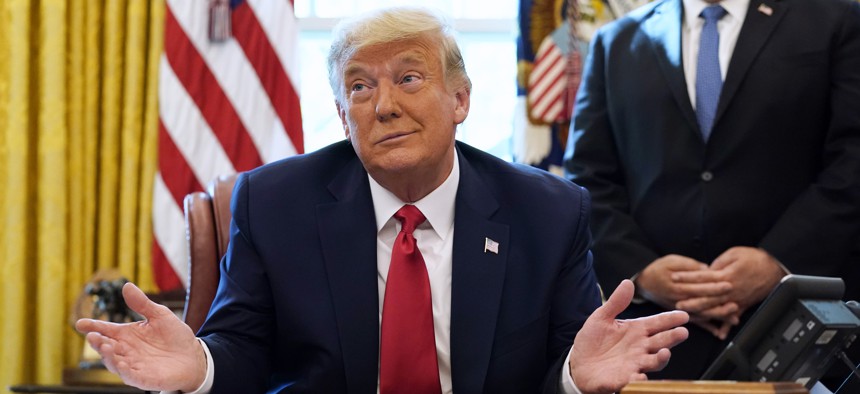
President Donald Trump listens while on a phone call with the leaders of Sudan and Israel, in the Oval Office of the White House, Friday, Oct. 23, 2020, in Washington. AP Photo/Alex Brandon
The October (or November) Surprise Neither Trump Nor Biden Wants
We need independent, scrupulously apolitical intelligence analysis in the White House that can compete with our worst instincts.
The risk is real. At least until January 19, 2021, in Donald Trump we have a president who makes many big national security calls on instinct. We saw it in the snap announcement that thousands of troops would be withdrawn from Germany; we saw it in the surprise threat to pull our people out of the embassy in Baghdad; and we saw it in a stunning tweet claiming that all U.S. troops in Afghanistan would be coming home for Christmas. Meanwhile, the administration has torn down one by one the international arrangements designed to reduce threats and prevent miscalculations: the Iran nuclear deal, the Intermediate-Range Nuclear Forces Treaty, and the Open Skies Treaty, just to name a few.
The replacement deals we were promised, like the president’s nuclear agreement with North Korea, have come to nothing. The result: a tinder-box world, and a White House with a fistful of matches. That reality leaves us open to high-stakes errors and dangerous crossed signals.
Information matters, and the White House’s continued willingness to traffic in misinformation is a security threat. Just take the recent information offered in a shady pedigree concerning Hunter Biden. It is now widely discredited, but the next sketchy dossier sent the president’s way could contain anything — suggestive chatter about Iran threatening our troops, or its path to the bomb. Will it be vetted before a response is unleashed?
Or imagine this: a video clip surfaces on the Internet, quickly going viral. It depicts a prominent Saudi leader claiming responsibility for hacking Iran’s drone fleet and using it to murder a very senior Iranian official under cover of darkness. What happens next? For all the talk about deepfakes, this one was just a good cheapfake with spliced audio and images made to look like it was filmed secretly on a cell phone. But it works, because Iran can’t immediately verify the authenticity of the video as it scrambles to assess whether its drone networks are actually compromised and guess which official might be at risk. As chaos ensues, bad decisions based on bad information are made not only by the Iranians but also the Saudis and their allies. The U.S. intelligence community works to try to validate or discredit the video but even as a cheapfake, the quality is realistic enough and the producer an expert. Night falls and the Iranian Revolutionary Guard decide they have no choice but to launch a missile across the Persian Gulf.
A little over 100 years ago, a shocking assassination in Serbia thrust the world into a global conflict and a similar miscalculation could all too easily happen again. To manage these risks, we need an intelligence and national-security process that can sort bluff and feint from real-deal threats — dross from gold. Instead, though, we’ve degraded those institutions too. Unofficial channels to the Oval Office have multiplied; now, the president is getting informal intelligence from Rudy Giuliani, or social media, but seldom from the President’s Daily Brief. Meanwhile, official channels have been politicized. We’ve seen troubling reports that analysts are asked, or tacitly expected, to downplay threats leadership doesn’t want to hear about, particularly white supremacist terror groups and Russian election interference (even at a rushed press conference on the eve of tonight’s Presidential debate). One week before Election Day it is being reported that if he wins reelection, three of the president’s most important national security team leaders — the defense secretary, the CIA director, and the FBI director — may be replaced immediately.
We’ve seen this movie before, and it doesn’t end well. The use and abuse of under-vetted information, flowing to the White House outside the boundaries of the professional national-security process, was a key ingredient in the Iraq War disaster. And as much as the administration might think coloring outside the lines serves its short-term political goals, in the end it never benefits the commander in chief to be making decisions with blinders on.
To avoid the kind of “October surprise” — or a November one — neither Trump nor Joe Biden wants, we need to fortify the guardrails that ensure our leaders see all the whole picture, including the facts they need to put mis- and disinformation in context. It means the president’s advisers need to insist on putting facts forward, to make sure that misinformation, if it can’t be prevented from landing on his desk, always appears next to the intelligence community’s official sense of its worth and weight. It means strengthening protections for whistleblowers and inspectors general, who can flag when the intelligence process is going off the rails. And it means, ultimately, that the president’s advisers (especially a director of national intelligence) believe that the White House’s interests are always best served by independent, scrupulously apolitical analysis.
There’s no denying it: Disciplining the White House’s information supply chain in this way is hard, in any administration. Leaders trust who they trust, they read what they read, and chasing stories that are too good to check is human nature. But the work is critical, because the price we pay for just one missed step can be staggering. We need to invest in an intelligence infrastructure that can compete with our worst instincts, with a news cycle soaked in half-truths, and with the foreign adversaries looking to get us tripped up. And we need to start yesterday.




